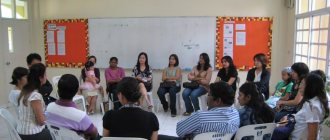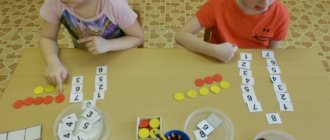Integrated learning technology
The concept of integrated learning includes not only a tolerant attitude, but also the use of modern technologies in education. After all, the transition to this type of progressive education requires modernizing the entire school system. Namely:
- attract the necessary specialists who will assist teachers during teaching;
- use innovative pedagogical solutions and ideas;
- adapt the curriculum to take into account the characteristics of all children in an integrated class;
- place emphasis on the development of creative and cognitive abilities;
- actively involve parents in the educational process.
When working with special children, the teacher needs the help of a specialized specialist
Who is suitable for integrated learning?
The methodology of integrated education comes from a special (correctional) approach to teaching children with disabilities. At first glance, it may seem like a panacea, but this is not entirely true. Integrated education has problems - it is not suitable for all children with inclusion.
Before deciding on integrated education for a child, it is worth showing it to a specialist. He will take into account whether there are external and internal conditions that signal that children are ready for this form of study.
| External conditions | Internal conditions |
| functional disorders were identified at the earliest stages of life | the degree of inclusion does not prevent the child from studying with other children |
| parents are serious about helping their child in the learning process | the child’s abilities allow him to master the curriculum in full |
| there is an opportunity to organize qualified correctional work | the child is psychologically ready for school |
| there are conditions and environment for integrated learning |
If a child has significant deviations in his psycho-emotional and physical condition, then no matter how strong the parents’ desire to educate him in a regular school, in this case it is better to choose a specialized (correctional) class.
Principles of integrated learning
Integrated learning has its own principles and features:
- develops the individual characteristics of each child;
- creates conditions for close interaction between the school, teachers, specialists and parents;
- teaches a specific culture that helps children respect children who are different from them and accept differences without offending others;
- creates a supportive space where every child feels valued and able to cope with all tasks.
Forms of integrated learning
According to the organization of the educational process, four forms of integrated learning are distinguished:
- attending a regular secondary school class;
- attending a special class in a secondary school;
- studying in a correctional school with subsequent transfer to a general education school;
- full or partial inclusion in the educational process during vocational training.
By the way! Our readers now have a 10% discount on any type of work.






